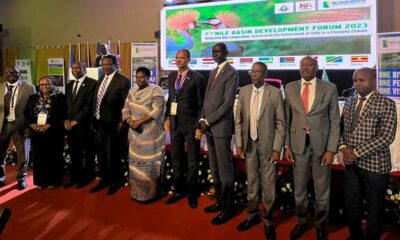human traffickingFeatures
How the Nile swelled and triggered cooperation among countries

Patrick Kahangire, a Nile Encyclopedia, on the history of Nile Cooperation
As citizens from across 10 countries that make up the Nile Basin meet in Kigali today to mark the 20th Anniversary of the founding of the Nile Basin Initiative, The Sunrise, traces the path that led to the historic event. Amazing how it started.
For more than 60 years since records of the flow of river Nile were taken, the average volume of water leaving Lake Victoria through the Nile was recorded at about 630 million cubic meters per second.
Then between 1961 and 1964, something dramatic happened. Many parts of Sub-Saharan Africa recorded extreme amounts of rainfall, according to Patrick Kahangire, Uganda’s first trained Hydrologist, now retired Senior Presidential Advisor on Water.
According to Kahangire, the rain was so much that it pushed water levels in Lake Victoria to rise by 3.2 metres. The amount of water flowing in the river consequently swelled to about 2000 cubic meters per second, more than three times the previous average flow.
The dramatic increase in the water levels proved more of a threat at time for Uganda but also other countries that share the Nile such as Kenya and Egypt.
“The port at Lake Albert was completely destroyed. The port at Lake Kyoga was also destroyed and so was the port at Kisumu in Kenya,” says Kahangire.
For Egypt, which had just completed the construction of Aswan High dam, the massive water flow threatened to destroy it, says Kahangire.
Ugandan officials too, were gravely concerned about the safety of Owen falls dam, whose sluice gates proved too small to accommodate the huge amount of water.
“Owen falls dam had been designed to accommodate relatively smaller amounts of water than it suddenly had to hold. There was fear that the dam would be over-topped,” recalls Kahangire who joined the Ministry for water as a pupil hydrologist, in 1975, after graduating from the University of Dar-es-Salaam.
Egypt, which was more scientifically advanced at the time compared to upstream countries like Uganda, made the first attempts at trying to find the causes of the high rise.
“Following that [incident], countries in the Nile basin such as Uganda, Kenya and Egypt wanted to have an understanding of whether what had happened was a historic event which could re-occur, or [whether] it was once in a lifetime event. But because of the destruction that it had caused, Uganda was interested. We got involved so that we could understand the bahaviour of the Nile basin, because without understanding the behaviour of the resource, you cannot plan for it.
The fact that Uganda’s only source of electricity – the Owen falls dam, was threatened, made Uganda’s involved even more critical. “It was very important for the economy of this country and we had to get involved,” recalls Kahangire.
With the help of the United Nations Development Programme (UNDP), Egypt approached Uganda, Kenya, Tanzania and Sudan with an idea of studying the hydro-meteorological aspects of the catchments of lakes Victoria, Kyoga and Albert, as a way of finding what had triggered the sudden increase in rainfall.
Going by the speeches of the leaders of all the five countries, obtained from historic archives, Egypt’s proposal received overwhelming support and goodwill. The project titled; Hydrometeorological survey of the catchments of lakes Victoria, Kyoga and Albert was launched in 1968 in Entebbe, Uganda.
The launch of the hydro-met survey, as it came to be known, kicked off the cooperation over the Nile river that was is being witnessed today. It later expanded to include all the 10 countries in Nile basin.
Although the hydro-met survey formally ended in 1992, the participating countries had found enormous benefits from coming together, including building technical capacities of staff in government departments, but more so in potential for ensuring a more coordinated and sustainable use of the Nile’s water resources for economic development.
So, efforts at cultivating and strengthening the cooperation continued in later years, despite political turmoil in Uganda, which resulted into the establishment of the Nile Basin Initiative (NBI) in 1999, which is celebrating exactly 20 years of existence on February 22, 2019.
Comments


























